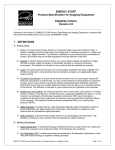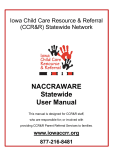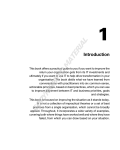Download Volume 2 Issue 2 - Ronald V McGuckin and Associates
Transcript
January 2008 Volume 2 Issue 2 Experience The Childcare Professional A Quarterly Journal for Childcare Providers Discussing Legal, Administrative & Professional Issues On the Inside… Helicopter Parents Page 1 Strategic Planning Page 2 Dismissing A Child... Page 3 The Role of the Facilitator Going Green Page 4 Guest Contributor: Tym Smith Children’s Book Corner Page 5 A Color of His Own By: Leo Lionni Child Abuse Statistics Page 5 Learning Stations Page 5 Implementing them in your classroom A look at At-Will Employment Page 6 Where in the World… Page 8 DEALING WITH “HELICOPTER PARENTS” By: Dawn K. Martini Since you are all employing Generation Y folks, you are probably familiar with a new trend called “Helicopter Parents.” Generation Y is defined as persons born between 1977 and 1991. These are young people who can not remember a world where there were not home computers, cable television and the internet. Helicopter Parents are the parents of these Generation-Y-er’s who “hover” over their children and micro-manage their lives. They complete their children’s college applications, follow-up after job interviews to inquire on their child’s performance, and call their child’s employer to ask about any manner of employment related issues from disciplinary actions, job reassignments, promotions, raises and the like. We have seen helicopter parents at work in some of our client’s centers. At one child care program the owner was dealing with a clique of three “20something” staff members. The staff members were gossipy, unfriendly and were so busy with everyone’s business that they were not performing their jobs adequately. The owner felt that if the young women were separated they would be better able to focus on the assigned tasks and would be better employees. Following the reassignment to different classrooms and even different sites, one of the young women’s mothers contacted the owner and complained that her daughter no longer liked work since she is not in the room with her best friends. Further, the mother of the employee claimed that the owner had no business reassigning her daughter and should move her back to where she was happy. The owner was shocked and appalled by this mother’s presumption that she would have any influence over her grown daughter’s employment status. She was further appalled by the employee’s lack of humiliation or embarrassment at her mother’s actions. As an employer you are only required to discuss matters of employment with the employee or their attorney at law. It is important to include “at law” when referring to an attorney because a parent or spouse could claim to be an “attorney of fact.” With the upsurge in meddling parents and spouses it has become important to inform employees that you will only address employment related concerns with the employee or their designated Attorney at Law. This includes sending out copies of personnel records. Certainly in emergency situations you will discuss the employee with the person(s) listed on the employees emergency contact form. This is limited to health related and/or crisis management situations, for example the employee is in a car accident in the parking lot; the employee has a seizure in the classroom etc. The employee’s emergency contact would also be able to call in emergency situations to inform the employer that the employee is unable to report to work. The Continued on page...2 Strategic Planning: The Facilitator By: Dawn Martini As you begin the Strategic Planning Process it is helpful to consider using an independent third party in the role of Facilitator. Someone who can be objective, critical and impartial. The Facilitator’s main function is to move the Strategic Planning Team through the Process. How this is done depends on the Facilitator’s personal style. A good Facilitator can adapt their personal style to fit the mood and character of each group with which they are working in an effort to yield the best final product. The benefits to having an independent person function in this role can be seen on many different levels. As an outsider the Facilitator is less intimidating to the employees and parents on the team which may make their participation more free and easy. Often, when projects are lead by insiders such as senior management and/or owners, employees and parents are reluctant to speak up and offer their suggestions for fear of being wrong or saying something that goes against the agenda of the manager or owner. With the independent third party running the meeting, employees and parents tend to relax and engage more freely in discussion and offer up more ideas. An independent Facilitator can act as a moderator throughout the Strategic Planning meetings moving discussions along in a timely and purposeful way. When issues become heated, overly deliberated, and/or unproductive the Facilitator’s role is to take control of the meeting and reel everyone in and back on task. If an insider were in the position to cut someone off or to stop discussion of a point, other team members may see that person as having an agenda or taking sides, which ultimately curtails the creative process. Overall, the Facilitator’s role is to move the Team along, not to be the expert who writes the Strategic Plan for the organization. The Team members are the ones who know the organization and will be the best resource for ideas and plans on how to move the organization forward. A good Facilitator works to bring out the ideas and thoughts of the Strategic Planning Team with minimal interference. In many cases, facilitators will also be the recording Secretary for the group so Team members are free to think about and discuss issues without the pressure of keeping accurate notes and then typing and editing the notes into report format for review and use at the next meeting. While it is important to select a Facilitator with experience and cursory knowledge of the Early Care and Education field, he/she need not be the leading expert in all things child related. Their expertise should be in the area of the Strategic Planning Process. To find a Strategic Planning Facilitator email Dawn at [email protected]. Next Issue: Setting the Ground Rules Continued from page 1… Helicopter Parents employer would then correspond by letter with the employee related to leave benefits and continuation of employment as per the personnel policies. If the employee were to be incapable of communicating the employer would communicate with whoever is designated as next of kin. If the person is married, it would be their spouse; if the person is an unmarried adult, it would be their parent or other designated adult. In all other non-emergency situations it is appropriate for the employer to say in a firm manner that they will not discuss the matter, that the parent/spouse should not call the program again and then promptly end the conversation. The employer should then meet with the employee and reaffirm the policy with them. A new personnel policy addressing Helicopter Parents/Spouses has been included in the Model Personnel Policy Manual Fourth Edition, available now by downloading and completing an order form from our website: childproviderlaw.com. Publisher Ronald V. McGuckin and Associates Post Office Box 2126 Bristol, Pennsylvania 19007 (215) 785-3400 Childproviderlaw.com Editor Dawn K. Martini, BS Ed Contributing Writers Ronald V. McGuckin, JD Dawn K. Martini, BS Ed Jason D. Dalton, JD Janice A. Nieliwocki, BS Guest Writer Tymothy Smith Copyright 2006 RVM & Associates All rights reserved. Reproduction in whole or in part without permission in prohibited. The Experience provides information about current developments, trends and issues. It does not offer solutions to individual problems and it should not be construed as legal or professional advice or opinion. You should obtain competent legal advise for an individual issue or problem. WHEN DISMISSING A CHILD IS THE RIGHT THING TO DO... By: Dawn K. Martini You have the right to dismiss any child, with or without cause, from your program if the reason for dismissal is not based on any of the federal, state, or local areas of protections. Generally, these areas include: race, color, creed, religion, gender, national origin and disability. Some states and/or local governments also protect sexual preference or sexual orientation and a few states also protect “marital status”. While the latter examples are usually not at issue with the children they may become an issue if the reason for dismissal can be tied to the parents membership in one of the protected classes. You should be sure to include in your Contract for Services/Fee Agreement a statement that reserves the right to dismiss a child/family at any time in the agencies sole discretion. You should again restate this policy in the Agency’s Parent Handbook. Your Contract for Services/Fee Agreement and your Parent Handbook should also state your policy regarding a refund of pre-paid tuition and or security deposit when a child is dismissed. Generally, you have the right to set policy in this area as long as your policy does not go against the law or public policy, it should be enforceable as a part of your contract. You need to be particularly careful when dismissing a child who suffers from a disability. This area presents the most exposure to potential liability for the agency. Dismissing the child because you or your staff Our Guest: TYM SMITH Tym Smith is a friend and colleague from Dallas, TX who will be contributing his wealth of expertise in the Early Care and Education field with us in many up coming issues. As a former teacher, center director and regional manager for one of Texas’ largest most influential child care companies, Tym offers practical and hands-on experience you our audience. Tym trains thousands of child care professionals throughout Texas every year on topics including, Supervision, Safety, Men in Child Care, and many others. He has written several publications and a Pre-service Manual for Texas providers based upon mandated standards in Texas Licensing Regulations. To learn more about Tym Smith or to see what products and services he may be able to offer your program, please visit his website: tymthetrainer.com is unfamiliar with how to accommodate a disabled child is illegal. However, if a disabled child presents an unsafe environment for him/herself, other children, or your staff, dismissal would be permitted. The unsafe environment must be real and not imagined or supposed from prior experience with other children with the same or similar disability. Each child must be evaluated on their own merits and circumstances. If your program is “publicly funded educational institution”, such as a school district or a Head Start program, you are also required to comply with IDEA (Individuals with Disabilities Education Act). IDEA does not allow for the dismissal of a child for unsafe behavior if the unsafe behavior is a direct result of or a manifestation of the child’s disability. In circumstances where a program is subject to IDEA’s regulations, a program would be required to do everything necessary to provide the child with an individualized and appropriate education. The decision to dismiss a child should be left to senior administration and owners, and in most cases the administrator/owner should consult with legal counsel before taking action. For a sample Dismissal Policy and Contract for Services/Fee Agreement visit the Publication section of our website, download the Publication Order Form and purchase Model Forms for Child Care Agencies and Model Parent Handbook for Child Care Agencies. 20 Tips for “GOING GREEN” in the Classroom By: Tymothy Smith To be “GREEN” means to conserve natural resources and consume consciously to reduce our impact on this big blue planet we call home. If everyone does something, it would have a tremendous impact on our world and the legacy we leave for future generations. Carbon Dioxide gas (CO2) is the major cause of climate change in the world. Humans are emitting millions of pounds of CO2 gas into the environment. CO2 gas is referred to as a “greenhouse gas” because it allows sunlight to enter the atmosphere, similar to the glass of a greenhouse, and it keeps the heat inside. This warms the planet. You can use the following tips to help do your part to keep the world a “greener” place: ♦ Turn off your classroom lights and restroom lights when children are not in the room. You may also consider installing motion sensors to activate lights when needed. Shutting off the lights cuts carbon emissions by reducing electricity use. ♦ Work with the children to turn the water on and off when washing hands, instead of leaving the water to run continuously. The average faucet releases about 3 gallons of water a minute. The average person wastes about 30 gallons of water a day. ♦ Check your toilets daily to ensure that they are not running continuously. This is a common problem in our classrooms and toilets can run for days until maintenance can fix them. Take action yourself. ♦ Move your thermostat closer to the outside temperature. Do not open windows when the A/C or heat is on. Moving your thermostat just 2 degrees closer to the outside temperature will save over 500 lbs of carbon dioxide from entering the atmosphere in a year. ♦ Completely shut down computers, chargers, and printers. Un-plug them from the walls when they are not in use. Even when computers are in a shut down mode, they are on stand by and still pull electricity. ♦ Trade in your light bulbs. Start using CFL lights. CFL light bulbs are 70-75% more efficient than the incandescent light bulbs we currently use. ♦ Recycle paper! And only use recycled paper in your classroom. Most newsprint is made of between 70100% new fibers from virgin trees. Recycled paper uses 60% less energy to make than virgin paper. Each ton saves 7,000 gallons of water and 17 trees. ♦ Plant a pollinator garden on your playground or in your flowerbeds. Yellow, blue, and purple flowers attract bees, while red and orange attract Hummingbirds. Pesticides, pollution, and habitat destruction are taking a toll on our birds and insects that pollinate about 80% of the world’s food supply. ♦ Get your kids outdoors more often! The best way for us to protect our resources for the future is by helping children develop an appreciation for the outdoors. ♦ Use Organic food in the classroom. Avoid serving foods that are labeled “Natural”. Natural does not equal Organic and these foods may still have nasty stuff in them! ♦ Plant a Tree! Even better, plant several trees! Trees are like natural air conditioners. They lower the temperature, filter air, remove carbon dioxide, absorb storm water and provide shade and beauty. A single tree will absorb a ton of CO2 over its lifetime. ♦ Use re-usable cups and plates instead of disposable cups and plates. ♦ Think twice before throwing something away! Ask yourself, can it be re-used or recycled? ♦ Help the butterflies by planting milkweed seeds in your flowerbeds. Butterflies are bio-indicators that scientists look to for signs of landscape quality and habitat loss. ♦ Don’t print everything! If you don’t need it, don’t print it! Have children work on dry erase or individual chalkboards more and avoid using so much paper! ♦ Evaluate the curriculum. Are there additional ways to incorporate environmental sensitivity and education into the classroom? ♦ Evaluate student activities. Are there other ways to introduce students to environmental studies or to increase environmental sensitivity? ♦ Encourage parents to car pool or use public transportation when coming to your school! ♦ Have a parent meeting or training on how they, too, can be green at home! Start small! Don’t try to make all these changes at one time. Turning your classroom Green one step at a time will make a huge difference in our future! Who’s mistreating children? Learning Stations in Your Classroom A recent USA Today article sites a Administration for Children and Families summary which illustrated that of the cases of child abuse and neglect reported to the ACF in 2005 40% of the children were mistreated by their Mother, 18% by their Father, 17% by both Mother and Father, and only 11% by a non-parent. This summary shows that children are 6 times more likely to be mistreated by one of their parents then by a non-parent and are twice as likely to be mistreated by their Mother than by their Father. Surprising? Disturbing. By: Janice Nieliwocki The previous two issues of “The Child Care Provider Experience” addressed Learning Stations for the preschool classroom. If you’ve been keeping up with the articles, you already know that Learning Stations are individual areas set aside in your classroom for small group interactive learning. Each area is equipped with teacher developed materials and activities designed to teach or reinforce a specific skill or concept. They can be of various formats and can be designed using a curriculum theme or children’s book as the central focus. Several related “stations” are set up simultaneously and children, in small groups, rotate through the various stations. You also know of the far reaching benefits you can expect to experience once you’ve incorporated Learning Stations into your preschool curriculum. What you may be wondering, however, is how to successfully implement Learning Stations into your particular classroom environment. Every classroom situation is somewhat unique and comes with its own set of circumstances, which you will need to assess prior to incorporating Learning Stations into your curriculum. Keep in mind that most circumstances can be easily addressed, and, with a little ingenuity and some simple alterations and modifications, Learning Stations can complement any preschool classroom. You may want to begin by first taking a look at the physical setting of your classroom. Because Learning Stations require small groups of children to rotate from one Station to the next, you will want to place the Stations in a format so that transitions run smoothly and chaos is kept to a minimum. This may simply require the rearranging of furniture, or just using a portion of your classroom for your Learning Stations. Perhaps a more daunting challenge is incorporating Learning Stations if you are working with a large number of children in your classroom. But don’t be discouraged, as there are several options you may wish to consider. Although I found the ideal number of workable Learning Stations at any given time to be three, a fourth Station can be added. (You may want to consider making the fourth Station a related art activity). Another option you may wish to consider when working with a large number of children is to simply divide the group in half, allowing half of the children to participate in supervised quiet play, while the other half of the children work with the Learning Stations, with the understanding that upon completion children will switch activities. This may require extra supervision, so you may want to utilize volunteers. An additional concern often arises when implementing Learning Stations with younger children or less mature children. This can usually be remedied by providing additional support and supervision at each Station. You can also simplify or modify skill levels at each Station to better suit the children and their ability or developmental level. Successful incorporation of Learning Stations into your preschool classroom is achievable! Simply assess your classroom situation, determine how Learning Stations will best work for you, make the necessary modifications and get started on the road to a fun and rewarding experience. CHILDREN’S BOOK CORNER By: Janice Nieliwocki Now that the new year is underway, why not start it off by reading Leo Lionni’s A Color of His Own at story time? This charming tale, about a chameleon who longs to “fit in”, will delight toddlers and preschoolers alike. The story begins with the young chameleon’s realization that he is unlike the other animals in the animal kingdom because he lacks a color of his own. In order to remedy the situation, he decides he will simply stay on a green leaf, so that he will no longer change color. However, much to his dismay, as the seasons change, the colors of the leaves change, and ultimately, so does the young chameleon. The chameleon is forlorn and saddened until he is befriended by an older, wiser chameleon. They stay together and even though their color will forever change, their friendship endures and neither faces life alone. The chameleon’s saga is clearly conveyed by the author’s simple, yet concise text. The artistry, interesting, bold and colorful, easily captures the reader/listener’s attention and is the ideal accompaniment to the story. As new friendships are made and old ones rekindled with the start of the new school year, Leo Lionni’s A Color of His Own exemplifies the value of friendship and demonstrates how life can be easier with a companion by your side. Not only will this book be a positive addition to story time, it can serve as a valuable teaching tool in your classroom. Model Personnel Policies for Child Care Agencies FOURTH EDITION $175.00 Preferred Pricing available on orders paid in full in January and February 2008 Regular Price after Feb 29, 2008 will be This latest edition of our popular Model Personnel Policies for Child Care Agencies includes new policies addressing never discussed issues including Cell Phones, Internet Access, Helicopter Parents/Spouses and specific language designed to meet new national accreditation standards. As always the MPPM 4th Ed. comes with a CD for fast and easy edits and personalization! To order Download an Order Form from childproviderlaw.com or call 215-785-3400 Visa/MC Accepted AT-WILL EMPLOYMENT DOCTRINE AND TERMINATION By: Janice A. Nieliwocki You may have heard the term “at- will” employment, but do you really know the implications and ramifications it has with regard to the employment relationship? Fundamentally, the At-Will employment doctrine states that, in the absence of a contract or collective bargaining agreement, an employer may terminate an employee at any time for any reason (or no reason) and in turn the employee may do the same, that is leave the employment at any time, for any reason. Sounds simple enough, but things are often not as simple as they seem. So, whether you are the employer or the employee, it is beneficial to understand how the “At Will” employment doctrine can affect the hiring and firing process. The origin of the employment-at-will doctrine can be traced back to the late 1800s where it was first mentioned in a legal treatise, entitled Master and Servant, written by Horace C. Wood. Although, Wood cited four American cases which supported his statement about at will employment, it seems as if Wood took some liberties and wrongly described atwill employment as already being accepted by the courts. Within a short time various courts were citing the rule in his treatise and the rule became accepted law. Many believe that it simply reflected the laissezfaire attitude of the times. From that point forward, courts basically viewed the employment relationship as being on equal grounds. In the absence of a contract, there were no obligations attached to employer or employee. Employees were allowed to leave jobs they no longer wished to occupy and in turn employers were able to discharge employees they no longer wished to employ. Over the last several decades, however, the courts and legislatures have begun to view the employer-employee relationship in somewhat of a different light. The first challenges to the status of atwill employment came during the Industrial Revolution as employees formed unions and gained protection against certain employment actions. The federal courts have also added protection with the passage of the Civil Rights Act and subsequent laws, (including the American with Disabilities Act), which protected classes of individuals and prohibited Continued on page 7... ...Continued from page 6 terminations based on race, religion, creed, gender, age, national origin, disability, pregnancy and veteran’s status. And although the “at-will” employment doctrine still remains intact in most states, courts are now addressing terminations that may seem unjust. There are three major judicial exceptions to the employmentat-will doctrine. The first, known as the public-policy exception, is the most widely accepted exception. According to the January 2000 edition of “Monthly Labor Review,” 43 states recognize the Public Policy exception to at-will employment doctrine. The 7 states that DO NOT recognize this exception are: Alabama, Florida, Georgia, Louisiana, Maine, Nebraska, New York, and Rhode Island. This exception prevents terminations for reasons that violate explicit, and established Federal or State public policy. For example, it would be considered a wrongful termination if an employer were to fire a child care employee who reported suspected child abuse where the employer felt there was no such abuse. The employee was simply following public policy and the termination would be deemed unjust. The second major exception to the employment-at- will doctrine is known as the impliedcontract exception. Basically, there is no contract in place, however an employer makes oral or written representations regarding job security and the courts view it as an implied contract. This is often seen in cases where employee handbooks contain statements that an employee will only be terminated for “just cause” or references to employees as attaining “permanent status.” It may also involve oral statements made by the employer to an employee that “as long as you do a good job; we will keep you on staff.” 38 of our 50 states recognized the implied-contract exception as of Jan. 2001. The 12 states that DO NOT recognize this exception are: Arkansas, Florida, Georgia, Indiana, Louisiana, Massachusetts, Missouri, Montana, North Carolina, Pennsylvania, Rhode Island, Texas, and Virginia. In these 12 states the only recognized contract is one that is explicitly entered into by both parties whether in writing or by verbal agreement. The last exception, known as the covenant-of-good-faith and fair dealing exception, is only recognized by 11 states as of January 2001. It is the least recognized exception by the courts because it strays significantly from the traditional employment-at-will doctrine. It basically means that an employer’s decision to terminate an employee is subject to a “just cause” standard and that terminations made in bad faith are prohibited. Under the good faith exception, terminations and other employment actions that are not based on job related factors would be considered illegal. For example, an employee has worked for a child care director for many years and their children begin to date, as they know each other from High School. The young man breaks up with the young lady (who is the director’s daughter) and the Director takes her frustration out on the employee (mother of the young man) and demotes her to a classroom and/or schedule that is unfavorable or terminates her employment. As many child care professionals have experienced, this type of petty, silly unprofessional stuff occurs in our world all the time. In the 11 states that recognize the good faith exception, this scenario would be illegal. The 11 states are: Alabama, Alaska, Arizona, California, Delaware, Idaho, Massachusetts, Montana, Nevada, Utah, and Wyoming. Despite these relatively recent judicial and legislative adaptations at-will employment is generally alive and well. Contract employees (those that have a contract for employment or are covered by a collective bargaining union) are not at-will employees. Terminations for contract employees can only be carried out by the terms outlined in the contract. When terminating at-will employees (those with no contract), employers need to ensure that the firing cannot be deemed a wrongful termination. First, employers need to make certain that no Federal or State public policy is being violated. Second, employers need to make sure there is no suggestion of an implied contract, (either from an employee handbook that could be misconstrued as such, or verbal statements made by the employer to the employee suggesting terms of employment). Finally, employers in the 11 states that recognize the good faith exception should determine if the termination is for “just cause” and is not being carried out with malice or in “bad faith.” If employers use professional sense and make their employment decisions including terminations for job related and/or job performance related reasons the employer should remain well within the at-will employment parameters. To be sure, all employers should consult with local legal counsel when terminating any employee. For information on Personnel Policy language and an At-Will Employment Acknowledgment Statement please email us at [email protected]. WHERE IN THE WORLD... a day or two to our travel schedules to work with you. Contact us at (215) 785-3400 to see if we can visit your program when we are in town. Jan 25 - 27: Chicago Metro Ron, Dawn and Jan will be AEYC Chicago, IL. For infortraveling to the following cities mation go to for Local, State, Regional and National Conferences on the Feb 9: Pinellas County Early dates indicated. We welcome Childhood Association Clearyou to attend the conferences. water, FL. Information has been provided so you can contact the organi- Feb 14 - 16: Virginia Associazation conducting the training/ tion for Early Childhood Education Norfolk, VA. For informaconference. tion go to vaece.org If we are going to be in your state or area, we welcome you to contact us about coming to your program or organization to do a private training. The cost of bringing us in to your program or organization is significantly reduced because we are already traveling to your area. We certainly don’t mind adding Feb 22 - 23: Child Care Association of Sussex County, PA Mar 14 - 15: CITE Conference New Brunswick, NJ. For information go to cite.org Mar 14 - 16: National Child Care Association Annual Leadership Conference Long Beach, CA for information go to nccanet.org Apr 3 - 5: California Association for the Education of Young Children Long Beach, CA. For information go to caeyc.org Apr 17 - 19” National Association of Child Care Professionals New Orleans, LA. For information go to naccp.org Apr 20 - 24: National Head Start Association Nashville, TN. Mar 12 - 14: National After For information go to School Association Phoenix, AZ. www.nhsa.org For info go to naaconference.org May 1 - 2: Pennsylvania Head Start Association Harrisburg, PA.


























